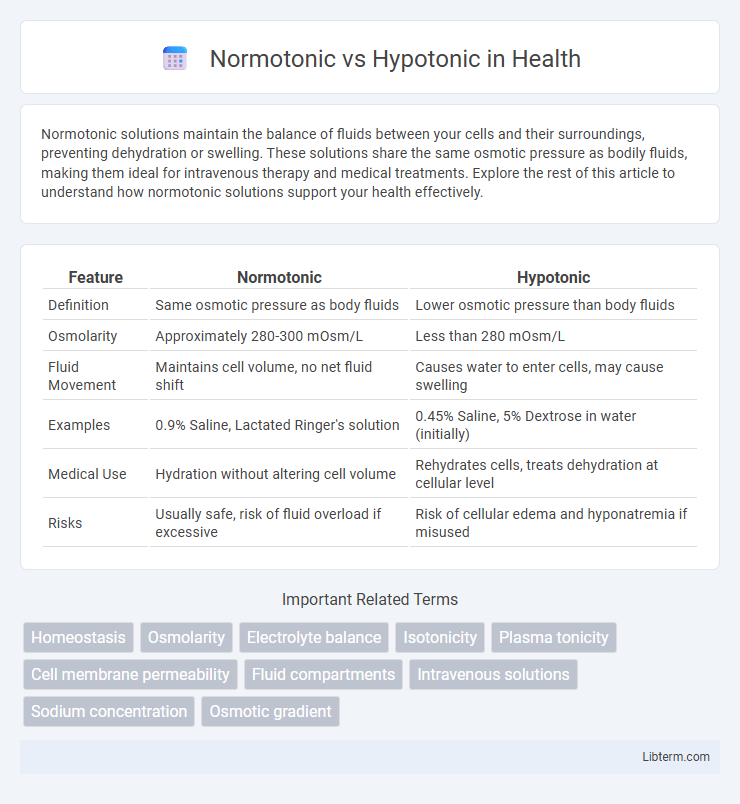Normotonic solutions maintain the balance of fluids between your cells and their surroundings, preventing dehydration or swelling. These solutions share the same osmotic pressure as bodily fluids, making them ideal for intravenous therapy and medical treatments. Explore the rest of this article to understand how normotonic solutions support your health effectively.
Table of Comparison
| Feature | Normotonic | Hypotonic |
|---|---|---|
| Definition | Same osmotic pressure as body fluids | Lower osmotic pressure than body fluids |
| Osmolarity | Approximately 280-300 mOsm/L | Less than 280 mOsm/L |
| Fluid Movement | Maintains cell volume, no net fluid shift | Causes water to enter cells, may cause swelling |
| Examples | 0.9% Saline, Lactated Ringer's solution | 0.45% Saline, 5% Dextrose in water (initially) |
| Medical Use | Hydration without altering cell volume | Rehydrates cells, treats dehydration at cellular level |
| Risks | Usually safe, risk of fluid overload if excessive | Risk of cellular edema and hyponatremia if misused |
Understanding Body Fluid Tonicity
Normotonic solutions have the same solute concentration as blood plasma, maintaining cellular fluid balance without causing cell shrinkage or swelling. Hypotonic solutions contain a lower solute concentration than blood plasma, leading to water influx into cells and potential swelling or lysis. Understanding body fluid tonicity is crucial for medical treatments like intravenous therapy, ensuring appropriate fluid replacement and cellular homeostasis.
What Does Normotonic Mean?
Normotonic refers to the condition where the osmotic pressure inside a cell or solution is equal to that of another solution, typically bodily fluids, resulting in no net movement of water across the cell membrane. This equilibrium maintains cell volume and homeostasis by ensuring neither swelling nor shrinking occurs. Normotonic solutions are critical in medical treatments like intravenous fluids to preserve cellular function and fluid balance.
Defining Hypotonic Solutions
Hypotonic solutions have a lower concentration of solutes compared to the inside of a cell, causing water to move into the cell by osmosis. This influx of water can lead to cell swelling and potential lysis in extreme cases. Understanding the osmotic balance between normotonic and hypotonic environments is crucial in medical treatments such as intravenous fluid administration.
Key Differences: Normotonic vs Hypotonic
Normotonic solutions have the same concentration of solutes as blood plasma, maintaining cell size by balancing osmotic pressure, while hypotonic solutions contain a lower solute concentration, causing water to enter cells and potentially leading to swelling or lysis. Normotonic fluids are typically used for hydration without altering cellular fluid balance, whereas hypotonic fluids are administered to rehydrate cells by shifting water intracellularly. Understanding this distinction is crucial in medical treatments to prevent cellular damage and maintain homeostasis during intravenous therapy.
Cellular Effects of Normotonic Fluids
Normotonic fluids have the same osmolarity as intracellular fluid, maintaining cell volume by preventing net water movement across the cell membrane. These fluids help preserve cell integrity and function, avoiding the risk of cellular swelling or shrinkage. Normotonic solutions like 0.9% saline are commonly used in medical settings to restore fluid balance without disrupting intracellular homeostasis.
Cellular Effects of Hypotonic Fluids
Hypotonic fluids have a lower solute concentration compared to the intracellular fluid, causing water to move into cells by osmosis. This influx of water results in cell swelling and can potentially lead to cellular lysis if excessive. Normotonic fluids maintain equal solute concentration inside and outside the cells, preserving normal cell volume and function.
Clinical Applications of Normotonic Solutions
Normotonic solutions, such as 0.9% sodium chloride and lactated Ringer's solution, are primarily used in clinical settings to maintain fluid balance and restore extracellular volume without causing cellular swelling or shrinkage. These solutions are ideal for treating patients with dehydration, blood loss, or electrolyte imbalances, as they help preserve hemodynamic stability and prevent cell damage. Their isotonic properties make them suitable for intravenous fluid therapy during surgery, trauma care, and critical illness management.
Clinical Applications of Hypotonic Solutions
Hypotonic solutions, containing lower solute concentrations than intracellular fluid, are clinically applied to treat cellular dehydration by promoting water movement into cells. These solutions are useful in managing hypernatremia, diabetic ketoacidosis, and conditions involving intracellular fluid deficits, restoring electrolyte balance effectively. Careful monitoring is essential to prevent potential complications like cellular swelling or cerebral edema during hypotonic fluid administration.
Risks and Precautions with Hypotonic Solutions
Hypotonic solutions carry risks of cellular swelling, leading to potential hemolysis, cerebral edema, or fluid overload, especially in patients with compromised renal or cardiac function. Careful monitoring of electrolyte levels, fluid balance, and neurological status is essential to prevent complications such as hyponatremia and increased intracranial pressure. Avoid administration in cases of intracranial pathology or severe burns, where fluid shifts can exacerbate tissue damage or edema.
Choosing the Right Solution: Factors to Consider
Choosing between normotonic and hypotonic solutions depends on the patient's hydration status, electrolyte balance, and cellular function needs. Normotonic solutions, like 0.9% saline, maintain fluid balance without causing cell swelling, ideal for fluid loss due to bleeding or dehydration. Hypotonic solutions, such as 0.45% saline, are appropriate for correcting intracellular dehydration but require careful monitoring to avoid cellular edema and electrolyte imbalances.
Normotonic Infographic

 libterm.com
libterm.com